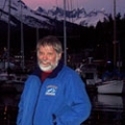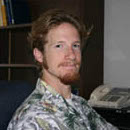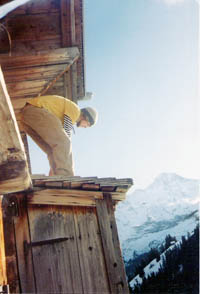Changes
The most noticeable change for 2007 - 2008 has been the absence of Tom Harman. Tom has moved to UAA; we all wish him the best. Tom has been replaced by Bryan Hitchkock, a former UAS student, UAA and Western Washington Graduate.
 A major news flash is that Ron Seater has decided to retire (from UAS, but not from commercial fishing), effective Spring 2008. Ron has been teaching at UAS since 1984 and has been instrumental in guiding the UAS mathematics program to where it is now. His dedication to his students and his commitment to the quality of the mathematics program will be missed.
A major news flash is that Ron Seater has decided to retire (from UAS, but not from commercial fishing), effective Spring 2008. Ron has been teaching at UAS since 1984 and has been instrumental in guiding the UAS mathematics program to where it is now. His dedication to his students and his commitment to the quality of the mathematics program will be missed.
 Andrzej Piotrowski will be joining the UAS mathematics faculty starting Fall 2008 to replace Ron. Andrzej is currently working at UC Fresno and, though he enjoys his work there, is looking forward to his move to Juneau.
Andrzej Piotrowski will be joining the UAS mathematics faculty starting Fall 2008 to replace Ron. Andrzej is currently working at UC Fresno and, though he enjoys his work there, is looking forward to his move to Juneau.
Andrzej received his B.S. and M.S. in mathematics from the University of New Hampshire and his Ph.D. in mathematics from the University of Hawaii, where he studied the distribution of zeros of entire functions under Dr. George Csordas.
Project SEED in Juneau
Early this year the mathematics program, with the help of the UAS Chancellor's Fund and in collaboration with Barb Mecum of Dzantik'i Heene Middle School, invited four Project SEED specialists to come to Juneau to give a demonstration of Project SEED teaching techniques at Dzantik'i Heene Middle School.
Project SEED is a unique non-profit educational organization that provides enrichment programs for students and professional development opportunities for educators. The mission and accomplishments of this remarkable organization is best described on Wikipedia at Project SEED Website.
Discussions on exploring a possible long term partnership including Project SEED, UAS and local Elementary and Middle Schools began in the Summer of 2007. The initial exploratory conversations between Project SEED and the UAS mathematics program proved promising and lead to further and broader discussions which included the UAS School of Education, Barb Mecum, the Principal of Dzantik'i Heeni Middle School Principal, and the submission and approval of a UAS Chancellor's Fund Grant Proposal.
On February 2, 2008 a panel discussion about Project SEED, at UAS, was lead by Hamid Ebrahim (National Director of Project SEED), Wayne Patterson (Board Chair and Program Manager NSF), Helen Smiler (National Projects Coordinator) and Howard Baker (NJ/Philadelphia Project SEED Site Director). This was followed by a week-long classroom demonstration by Howard Baker at Dzantik'i Heeni Middle School, February 2 through February 8. The purpose of this demonstration was to illustrate Project SEED's Methodology and effectiveness in the classroom. Based on feedback received from a variety of sources and observers, Project SEED's visit was a resounding success.
The above mentioned visit formed the first phase of what the mathematics program and UAS hope to be a sequence of events that will culminate in a long term partnership between UAS, Project SEED and the local school district (at the elementary and middle school levels).
What else?
Three UAS math majors will have graduated by the end of Summer 2008; Josh Galbraith (Spring 2008), James Bauman (Spring 2008) and Derrick Grimes (Summer 2008). James will be heading out to Oklahoma to attend Law School soon after graduation. Josh and Derrick have not divulged their plans as yet. These three will be followed soon after by Kevin Schriver, who is contemplating graduate school, and Dustin Raymond, who is contemplating a career in education by way of the UAS MAT program.
Jon Bower visited UAS with his graduate advisor, from UC Davis, in April as part of a summer REU recruitment effort. He was able to find time to give talks in a variety of classes Natural Sciences, including mathematical modeling.
Featured Student
Josh Galbraith

Josh spent most of his pre-college days between Kodiak and Sitka. He came to UAS from Sitka High School, even though this was not his plan at the time. Josh graduated with a BS in mathematics this Spring.
“I planned to take a year off from school and work, and then look for schools down south. Not long after graduating from high school a friend who was coming to UAS and asked me to join him. So I did. He left after a semester and I stayed on. I liked it here.”
UAS did not offer a BS degree in mathematics at the time, which was fine. Josh’s interests were in other subjects; like Art, English, Political Science and History.
“My interests were not in mathematics at the time. But, during my first two years at UAS, every time I took a math course – which was every semester – I found I did well. So I took more courses. Also, I found myself enjoying the subject more and more. Professors from other disciplines had suggested I major in their fields, but I ended up choosing mathematics first in the BLA degree program and then in the BS degree program once it became official.”
Graduate school is definitely in his plans for the future, but he is still thinking about in which discipline. What advice does he have for graduating high school students from Alaska, and out-of-state students? Well...
“For the Alaskan students, definitely stay in Alaska and preferably come to UAS. The benefits include in-state tuition, small classes and accessible faculty – and this is true not only for the math program. For out-of-state students, it’s worth coming to UAS. UAS has the nicest campus of the whole UA system, you can’t beat the faculty and opportunities for outdoor activities are awesome.”
Featured Graduate
Steve Perry
 Steve graduated from Juneau-Douglas High School in 2002 and came to UAS soon after. He graduated with a BS in mathematics in 2006 and is currently working full time at the Juneau Campus Testing and Learning Center. He also helps out the math program by teaching a remedial or developmental math course each semester.
Steve graduated from Juneau-Douglas High School in 2002 and came to UAS soon after. He graduated with a BS in mathematics in 2006 and is currently working full time at the Juneau Campus Testing and Learning Center. He also helps out the math program by teaching a remedial or developmental math course each semester.
“Following my public school experience, I had no intention of formally continuing my education, but my parents provided some convincing arguments in favor of going to college – they would cut me off if I didn’t. So, three days before classes began, I registered for classes at UAS.”
“Needless to say, I was not a very motivated student. But, I managed to pass all my classes fairly easily. I tested into college algebra and was intrigued by the more difficult test questions; Brian Blitz made the course challenging and interesting. This was encouraging, so I took more math courses; my attitude toward school did not change, but I started enjoying my math courses quite a bit more than I expected and did quite well in them. I began making friends that were math majors – in those days it was a BLA with a math emphasis. Interactions with them, Calc I and my first semester as a Learning Center tutor seemed to have been the deciding factor – I decided to get a degree in mathematics.”
“Since UAS only offered a BLA with an emphasis in mathematics, I went to the University Idaho on a student exchange to take more math courses and look into the engineering field; when I heard UAS had introduced a BS in mathematics, I promptly returned. I preferred the small class setting at UAS, so I finished my degree here.”
When asked about what he might say to students considering UAS, Steve became philosophical.
“My experience with the UAS math program left me fairly astounded. In fact, it seems like an obvious choice to take science and mathematics at UAS. A drawback at UAS is that it is a small school and so, by default, cannot offer the wide range of courses offered at larger schools. But, additional courses (of interest) can be taken through the Student Exchange Program. The class sizes at UAS are small, the professors are flexible and very accessible, and the school is small enough that you can get to know all majors in your discipline. It was great to be able to talk to upper level majors and get advice, and working as a tutor in the Learning Center helped me stay in touch with my earlier math.”
String Theory and the Alaska Folk Festival
 Some folks from different disciplines within the Natural Sciences Department teamed up to form a band this year. Kirsa Hughes-Skandjis (Biology), Alicia Hughes-Skandjis (Mathematics), Adrienne March (Environmental Science), Josh Galbraith (Mathematics) and Sarah Campen (Communication) tried their hands out at music in the 2008 Alaska Folk Festival held in Juneau this Spring.
Some folks from different disciplines within the Natural Sciences Department teamed up to form a band this year. Kirsa Hughes-Skandjis (Biology), Alicia Hughes-Skandjis (Mathematics), Adrienne March (Environmental Science), Josh Galbraith (Mathematics) and Sarah Campen (Communication) tried their hands out at music in the 2008 Alaska Folk Festival held in Juneau this Spring.
Their band, "String theory," was described as "a good concept with all the power of modern mathematics, but..." the question that was raised was "can they produce music?"
They did, and they did it very well. Having bought their instruments specially for the show, they expressed every intention to return next Spring and play for their fans once more.
 A major news flash is that Ron Seater has decided to retire (from UAS, but not from commercial fishing), effective Spring 2008. Ron has been teaching at UAS since 1984 and has been instrumental in guiding the UAS mathematics program to where it is now. His dedication to his students and his commitment to the quality of the mathematics program will be missed.
A major news flash is that Ron Seater has decided to retire (from UAS, but not from commercial fishing), effective Spring 2008. Ron has been teaching at UAS since 1984 and has been instrumental in guiding the UAS mathematics program to where it is now. His dedication to his students and his commitment to the quality of the mathematics program will be missed.  Andrzej Piotrowski will be joining the UAS mathematics faculty starting Fall 2008 to replace Ron. Andrzej is currently working at UC Fresno and, though he enjoys his work there, is looking forward to his move to Juneau.
Andrzej Piotrowski will be joining the UAS mathematics faculty starting Fall 2008 to replace Ron. Andrzej is currently working at UC Fresno and, though he enjoys his work there, is looking forward to his move to Juneau.
 Steve graduated from Juneau-Douglas High School in 2002 and came to UAS soon after. He graduated with a BS in mathematics in 2006 and is currently working full time at the Juneau Campus Testing and Learning Center. He also helps out the math program by teaching a remedial or developmental math course each semester.
Steve graduated from Juneau-Douglas High School in 2002 and came to UAS soon after. He graduated with a BS in mathematics in 2006 and is currently working full time at the Juneau Campus Testing and Learning Center. He also helps out the math program by teaching a remedial or developmental math course each semester. Some folks from different disciplines within the Natural Sciences Department teamed up to form a band this year. Kirsa Hughes-Skandjis (Biology), Alicia Hughes-Skandjis (Mathematics), Adrienne March (Environmental Science), Josh Galbraith (Mathematics) and Sarah Campen (Communication) tried their hands out at music in the 2008 Alaska Folk Festival held in Juneau this Spring.
Some folks from different disciplines within the Natural Sciences Department teamed up to form a band this year. Kirsa Hughes-Skandjis (Biology), Alicia Hughes-Skandjis (Mathematics), Adrienne March (Environmental Science), Josh Galbraith (Mathematics) and Sarah Campen (Communication) tried their hands out at music in the 2008 Alaska Folk Festival held in Juneau this Spring.